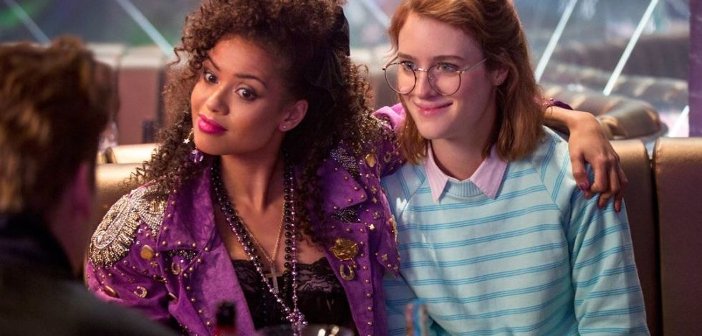Hacking, Gaming, Smartphones and Bees | Black Mirror‘s Third Season Shows Variety in Depicting a Not-Too-Distant Future
Another Netflix resurrection, Charlie Brooker’s ever-popular discomfort-athon Black Mirror, returned to us last week with a new six episode run. This time around the episodes focus on – and I hope you’re sitting down for this – how technology is evolving too fast and may be going too far.
The doubled episode count increases the likelihood of a dud rearing its head but it also means that such a dud is more easily buried. This is partially the case: the season opener ‘Nosedive’ – the only episode not written by Brooker – is easily the weakest, but the episodes become unquestionably stronger and more emotionally ruinous as the season progresses. This builds to a ninety-minute, feature-length finale titled ‘Hated in the Nation’ which, had it been released standalone, theatrically, could easily have stood on its own merits. A solid, murder-mystery police procedural that builds in scope, ultimately revealing itself as a modernised throwback to the old-fashioned type of horror/thriller where the antagonistic force was a none too subtle commentary on a contemporary societal ill. Cyber-bullying acts as subject here. It’s essentially The Birds but for the hacker generation.

The sting in the tale is as much a trademark of Black Mirror as the “how has technology gone too far this week?” angle, and this season is decidedly more self-aware about it. This is at its peak in ‘Playtest’ where the nature of its video game-inspired, Russian-nesting doll of a narrative means Brooker knows you’ll be looking for it, leading to scenes of the main character loudly trying to pre-empt the twist of the story he’s in. Elsewhere it’s a case of misdirection, with ‘Shut Up and Dance’ leaning on you to focus on the ‘why’ of the tale when in reality it’s the nature of our protagonist’s sin which is meant to be the real punch to the gut. (If you’re someone who focuses too heavily on questioning why a writer chooses to introduce a certain character in a particular way, you’ll have that twist worked out during the lead’s first moments onscreen.) Though the real twist of ‘Shut Up and Dance’ is ultimately its total lack of a sci-fi conceit; the mechanics of its plot are achieved entirely with available technology and all too believable motivations (or indeed, lack thereof).
Season 3 displays noticeably heavier videogame inspiration than previous seasons. Gamification inevitably plays a focus in any speculation of future tech and has done so in prior episodes (‘15 Million Merits’, say) but here the concept reaches its unsettlingly plausible peak in ‘Men Against Fire’. An army story about a zombie infestation of sorts, it deals with military conditioning and dehumanising with a midpoint revelation that’s particularly chilling and bleak, even by the show’s usual standards. That such tech can’t be far away and that military deployment of it in the manner dramatized is so possible, really does drain you of any remaining hope you may foolishly have held onto. ‘Playtest,’ though, is Brooker finally having fun with the medium; given his enthusiasm and knowledge of gaming, it’s surprising it took three seasons to get an episode like this. A VR-infused haunted house story on the surface, the story plays with character (and audience) gauge of what onscreen is actually taking place and what is not. Romp-like, clever and with a particularly nice ‘Bioshock’ reference buried in its frantic third act, it’s probably the most outright ‘fun’ episode of the batch.

Over the six episodes, the assorted directors bring a nice variety of visual styles to their various depictions of Brooker’s nightmare futures. ‘Nosedive’ and ‘San Junipero’ both occupy Her-like clean and vibrant worlds; calmly-coloured glass and steel is blended with unattainable promises and false smiles. ‘Playtest’ combines a grittier and more desaturated look for its setup before moving into a higher contrast, heightened look for its fire-lit spook-house action. ‘Men Against Fire’ commits to a washed out, handheld aesthetic which fits its dour tone and intense, isolated action with ‘Shut Up and Dance’ aiming for something similar. They both visually fit in comfortably with Ben Wheatley’s usual depictions of England and, thinking on it, he’d be perfect to direct a future episode. ‘Hated in the Nation’ feels the most accomplished, effecting a sleek, modern crime-thriller look in the vein of the various Scandinavian entries in the genre. It lends a realism to what likely sounded like a farcical, almost comic book-y plot on paper.
Through all of this, the show’s strength continues to be its subtle but rich world-building which ground even the more exaggerated premises in all too believable realities. It’s interesting how in season one there was some new gadget introduced in almost every episode, yet by the time we reach the current season the various universes these stories take place in seem to have settled into similar technologies as an inevitable occurrence. The prevalence of omniscient uniform smart devices, ocular implants for minor augmented reality layering and self-driving cars don’t feel at all like wild leaps of speculation and it’s refreshing to see that Brooker doesn’t assume they’ll try to destroy our lives in their own individually Faustian ways. Which brings us to one of the episodes getting the most attention; ‘San Junipero’, the sacrilegious “hopeful” episode. To clear up that issue, just because something isn’t void-staring-ly bleak, doesn’t make it hopeful by default. It is an interesting mid-season palette cleanser after the previous episode and does provide a rather sweet, yet melancholic love story that puts its focus on both LGBTQ+ and elderly characters. Its finale is no doubt someone’s idea of hell but then, there’s no pleasing everyone.

Splitting up what was originally conceived of as a single twelve episode season into two shorter ones half that length was undoubtedly the right call. Long enough to showcase variety but short enough that the production isn’t stretched so thin as to make something as ambitious as ‘Hated in the Nation’ unviable or an episode as indulgent but slight as ‘Playtest’ get lost in the mix. It will be interesting to see after the next series – which reportedly has landed Jodie Foster to direct – just how much variety of fear Brooker has left in him for a future we seem to increasingly be already in but if these six are any indication, he’s lost none of his feel-bad appeal.
Every season of Black Mirror is available to stream on Netflix. View the trailer for season three below.
[youtube id=”jDiYGjp5iFg” align=”center” autoplay=”no” maxwidth=”750"]

